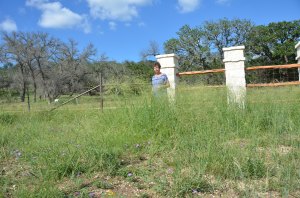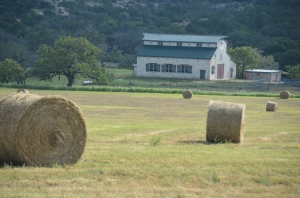How affirming those words, “hay is in the barn”. Have you ever wondered how hay is cut and baled? We cut our hay fields this week and baled both round and square bales. Below I share the process of carrying out this important ranch activity.
Two months ago our fields were brown and dusty. After our lengthy drought the fact that we obtained a cutting at all is fortunate. The process began two months ago.The rains this year came at the right time, namely just after we had fertilized the fields and then subsequent rain was well spaced till harvesting.
Being a small operator, we don’t own the cutting, raking, and baling equipment. Instead I hire someone with equipment and pay a per bale charge. The charge for cutting and baling our hay is substantially less than buying it, especially so during our recent drought years.
When the hay has grown and begun to head out, the tractor pulls the cutter through the fields and lays it down, much like a giant scythe. The hay then needs to dry for several days. Because of the threat of rain this year, we baled the Klein grass into bales before it had completely dried. Once the hay was cut and dried, the tractor pulled a giant rake through the fields, creating a large snake-like furrow of hay. Next the tractor pulled the baling machine through the field and picked up the rows of grass, turning it into thousand pound round bales or sixty pound square bales. The machine amazingly ties the bale tightly with twine or wire to hold it in place.
Given the higher than normal moisture content of the grass this year, we will leave the bales in the field for a week or so to dry before moving them to the hay barn. This interval diminishes the chance for spontaneous combustion. Yes, instances have occurred where barns have burned down due to prematurely enclosed hay bales.
Next week we will move the bales (both the large round ones for cattle and the smaller coastal square bales for horses) to the barn to store for the winter. Placing the hay in the barn is a particularly satisfying time, knowing the animals will have ample hay during the non-growing season.











